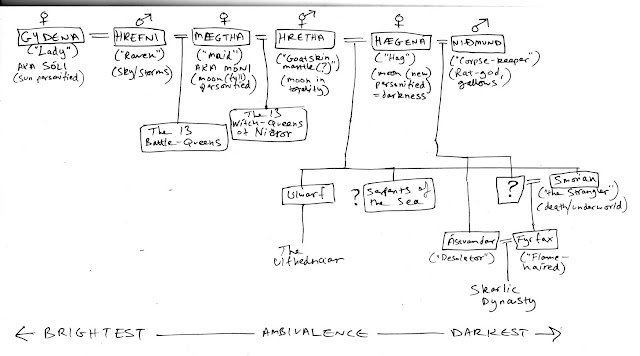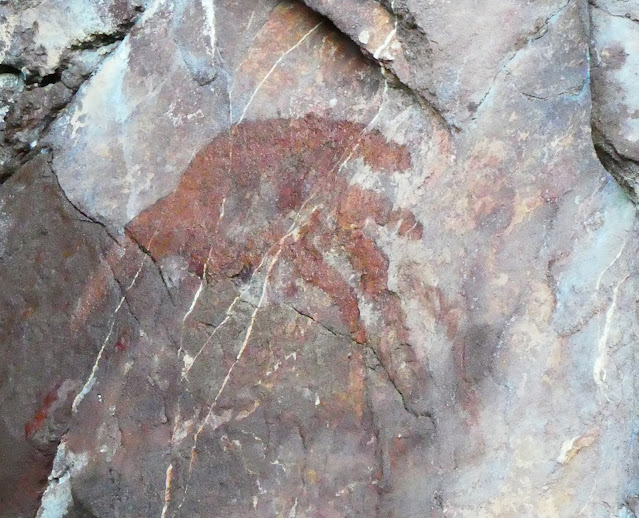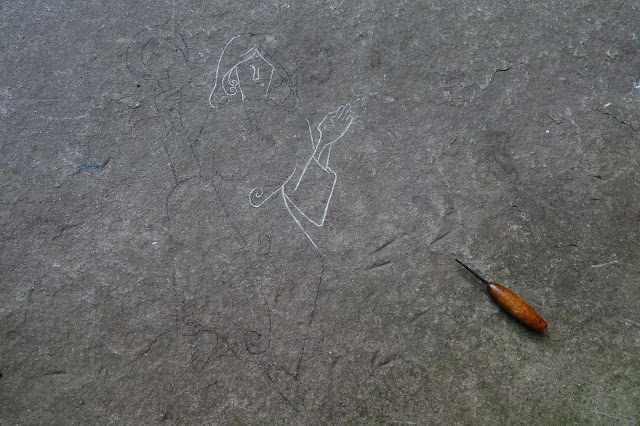Defining Divinity
As depicted above - this afternoon's exercise in trying to pin down the family tree and inter-familial relationship of the gods and the various progenitors. Some progress from my initial sketches of last year but still a fair few gaps remain: where does Ullek, the Rockcats' father (in truth, parent - since, according to Womba, Ullek can be 'both man and wife', much like Hretha) fit in? Nithmund, the rat-god, is still very vague (as perhaps such a grim character ought to be) and I have wondered if his role as guardian of decay, plague-bringer, gallows-friend and general king of corruption is not partly served also by Smorian, his step-daughter, who is queen of the dead and the underworld. But then, the roles of, say, Hekate and Hades are quite distinct and separate in Greek mythology and it occurs to me that Nithmund's function is one still rooted in the living world, with an effect upon those he touches: Smorian, on the other hand, is simply a harvester of souls, to whom all living persons are fettered, and - so the legends go - only a brave death in battle can sever her bonds, an act carried out by the war-daughters of Hrefni and Maegtha (valkyrjur in essence). Smorian's influence is only felt by those in extremis and indeed, both heroines (Womba and Gerthild), at various times, do meet her on the threshold of the underworld. Both are sent back before crossing the river Forgyettan (an act which removes all memories from the soul who crosses over, adding them to a great well of the thoughts and memories of all who ever lived - hence, a repository of vast knowledge, the kind of which re-appears in various mythologie).
In terms of gender, things are weighted 3.5:2.5 in favour of the feminine, with Hretha the ambiguous, hermaphroditic sibling of Hrefni, and lunar imagery outweighing solar - again, embedding the notions of balance (rather than outright matriarchy - the historical proofs for which, in its true form, are shaky, but - as presented by R. Graves, J. Harrison, J. Campbell etc., certainly inspire deep consideration. Alaric Hall in Elves in Anglo-Saxon England, p. 164, cites J. Bamberger's demolition of such theories in The Myth of Matriarchy: Why Men Rule in Primitive Society which I haven't yet read, but aim to). Rather than going out on a New-Age, re-imagined limb of speculation (a concept which I feel has only limited currency, at best, in academic discourse and which I criticize at some length in Slayers, Choosers, Witches and Wives: A Critical Analysis of the Wælcyrge’s Presence and Absence in Old English Texts), I have decided to keep things less radical and acknowledge the strengths of all genders (restoring the hermaphrodite to its rightful place in the process). After all, my two main characters (Womba and Gerthild) are female, with support from another hermaphrodite (Gifli) and a male warrior type (Ffreow), but it is around the female cast (Womba, Gerthild, the two witch-covens, Fyrfax) that the action pivots. Womba's tale of individuation - whatever may be the workings of wyrd - is one led by her own strength of will and mind, and usually with the best interests of others, rather than herself, at heart. Hrefni, a shadowy figure at best, is invoked and mentioned far less than the ever present Sóli (sun) and Móni (moon) - both of which are feminine deities. This female-centric core is only really countered by the gruff, heroic hypermasculine comitatus-culture of the Ulfhednaar, with human and rockcat societies sitting more or less around the middle. In total contrast to the dark, lunar Ulfhednaar, the bright, solar Ylfu have glorified the concept of the heroic female warrior almost to the point of apotheosis.
Using the Old Norse pantheon as a prototype has left a few issues: e.g., the original identification of Hretha with Loki gave them the offspring Smorian (=Hel), Ulwarf (=Fenrir) and originally the whole species of dragon-kin (=Iormungandr), but recent research into dragons and how I want them to be portrayed grants them elevated status now, to a role equivalent to that of the Titans of pre-Olympian Greece: primal elementals bold enough to battle the gods themselves (and, unlike the Titans, not actually lose). Hence the rather vague replacement with 'sea-serpents', although these perhaps could have grown from pet snakes of Hretha (identifying them with ancient, pre-Hellenic goddess cults) which were cast out from Hrefni's halls along with them and their brood.
The tripartite imagery of serpent/skull/wolf is a motif writ large upon the cosmos: echoing the three fateful children of Loki in Norse myth (Iormungandr, the world-serpent; Hel, goddess of the dead; and Fenrir, the giant wolf) it is explicit in the design of the throne of Fyrfax:
"The queen, in dark red velvets, sat
on giant throne, by Hretha carved, they said,
from a root of Ashentorr itself;
dire wolves its arms, its back, twin snakes;
the seat, a giant's skinless skull..." (Chapter XIII)
In this image, Fyrfax; the bloodthirsty immortal queen who wreaks havoc upon Gyldland for the sake of total conquest of the gods' dominion, is given mastery of the imagery of the netherworld: the wolf, whose cousins, the hell-hounds, guard the path to her hall; the serpents depicting the sinister and venomous (negative) aspect of the feminine, and the skull, as emblematic of the dead, the netherworld ruled by her mother, Smorian (herself a visual re-imagining of the goddess Hel: comely from the front, rotten and decayed when viewed from behind - a two-faced concept also associated with certain threads of folklore concerning the elves). Despite her terrifying habits and giant size, Fyrfax also embodies the same dichotomous relationship – that which also has echoes in Modthryth in Beowulf, whose presence some scholars have seen as a hint of the negative aspect of the valkyrie in OE literature (e.g. H. Damico).
As things stand, there is no god/dess of evil - corruption, death and decay are all part of natural cycles and, while unpleasant and even feared to a degree, the structure of the pantheon grants equal and shared power to all the major divinities: sun is not greater than darkness or decay, as one cannot be without the other, and both are equally essential to life. This essential level of understanding has been somewhat buried by real-world religious tradition for quite some time.




Comments
Post a Comment